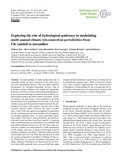JavaScript is disabled for your browser. Some features of this site may not work without it.
| dc.contributor.author | Rust, William | |
| dc.contributor.author | Cuthbert, Mark | |
| dc.contributor.author | Bloomfield, John | |
| dc.contributor.author | Corstanje, Ron | |
| dc.contributor.author | Howden, Nicholas | |
| dc.contributor.author | Holman, Ian P. | |
| dc.date.accessioned | 2021-04-27T15:00:14Z | |
| dc.date.available | 2021-04-27T15:00:14Z | |
| dc.date.issued | 2021-04-23 | |
| dc.identifier.citation | Rust W, Cuthbert M, Bloomfield J, et al., (2021) Exploring the role of hydrological pathways in modulating multi-annual climate teleconnection periodicities from UK rainfall to streamflow. Hydrology and Earth System Sciences, Volume 25, Issue 4, April 2021, pp. 2223-2237 | en_UK |
| dc.identifier.issn | 1027-5606 | |
| dc.identifier.uri | https://doi.org/10.5194/hess-25-2223-2021 | |
| dc.identifier.uri | http://dspace.lib.cranfield.ac.uk/handle/1826/16619 | |
| dc.description.abstract | An understanding of multi-annual behaviour in streamflow allows for better estimation of the risks associated with hydrological extremes. This can enable improved preparedness for streamflow-dependant services, such as freshwater ecology, drinking water supply and agriculture. Recently, efforts have focused on detecting relationships between long-term hydrological behaviour and oscillatory climate systems (such as the North Atlantic Oscillation – NAO). For instance, the approximate 7 year periodicity of the NAO has been detected in groundwater-level records in the North Atlantic region, providing potential improvements to the preparedness for future water resource extremes due to their repetitive, periodic nature. However, the extent to which these 7-year, NAO-like signals are propagated to streamflow, and the catchment processes that modulate this propagation, are currently unknown. Here, we show statistically significant evidence that these 7-year periodicities are present in streamflow (and associated catchment rainfall), by applying multi-resolution analysis to a large data set of streamflow and associated catchment rainfall across the UK. Our results provide new evidence for spatial patterns of NAO periodicities in UK rainfall, with areas of greatest NAO signal found in southwest England, south Wales, Northern Ireland and central Scotland, and show that NAO-like periodicities account for a greater proportion of streamflow variability in these areas. Furthermore, we find that catchments with greater subsurface pathway contribution, as characterised by the baseflow index (BFI), generally show increased NAO-like signal strength and that subsurface response times (as characterised by groundwater response time – GRT), of between 4 and 8 years, show a greater signal presence. Our results provide a foundation of understanding for the screening and use of streamflow teleconnections for improving the practice and policy of long-term streamflow resource management | en_UK |
| dc.language.iso | en | en_UK |
| dc.publisher | European Geosciences Union | en_UK |
| dc.rights | Attribution 4.0 International | * |
| dc.rights.uri | http://creativecommons.org/licenses/by/4.0/ | * |
| dc.subject | North Atlantic Oscillation | en_UK |
| dc.title | Exploring the role of hydrological pathways in modulating multi-annual climate teleconnection periodicities from UK rainfall to streamflow | en_UK |
| dc.type | Article | en_UK |
Files in this item
The following license files are associated with this item:
This item appears in the following Collection(s)
-
Staff publications (SWEE) [2844]

